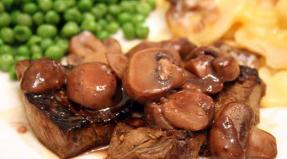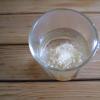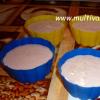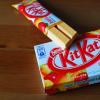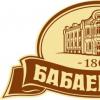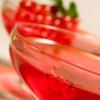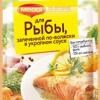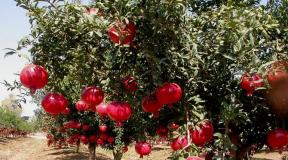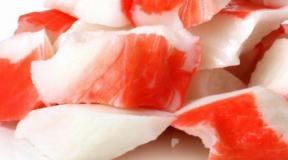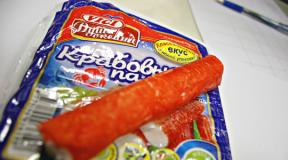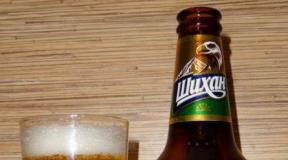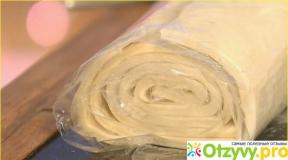Assortment and technological process of preparing complex hot culinary products from fish. Quality control of fish dishes
Send your good work in the knowledge base is simple. Use the form below
Students, graduate students, young scientists who use the knowledge base in their studies and work will be very grateful to you.
Posted on http://www.allbest.ru/
Ministry of Education of the Republic of Belarus
Educational institution
"Grodno State University named after Yanka Kupala "
Department of Technology, Physiology and Food Hygiene
Course work on the discipline: "Production technology Catering»
Topic: "Development of assortment and technology of dishes and fish products"
Specialty 1-91 01 01 Production of products and organization of public catering
Specialization 1-91 01 01 01 Product technology and catering
Completed: 4th year student of 4th group
E.I. Kazimirchik
Supervisor: teacher
L.V. Uleychik
Grodno 2014
WITHobsession
- Introduction
- 1. Study of the food and biological characteristics of a given raw material - uncut pink salmon, uncut carp
- 1.1 Characteristics of pink salmon
- 1.2 Characteristics of carp
- 2. Studying the assortment of dishes and culinary products from given raw materials
- 2.1 Boiled and stewed fish dishes
- 2.2 Fried fish dishes
- 2.3 Stewed and baked fish dishes
- 3. Preparation of raw materials for cooking fish dishes
- 3.1 Initial processing
- 3.2 Methods of heat treatment
- 3.3 Physicochemical processes during heat treatment
- 4. Requirements for the quality and serving of fish dishes
- 5. Use of fish waste
- conclusions
- List of sources used
- Applications
Introduction
Fish is a real storehouse of various minerals: iron and phosphorus, calcium and magnesium, zinc and selenium, which together with vitamins ensure the normal functioning of the whole organism.
The inhabitants of the depths contain vitamins necessary for our body (especially A and D), fats, proteins (fish meat contains 18% proteins). Proteins from fish meat are more easily absorbed by the human body than proteins from animal meat. A valuable component of fish, especially ocean fish, is fat. Fish oil is high in unsaturated fatty acids. Also, fish meat contains water-soluble vitamins: small amounts of vitamin C, as well as a complex of B vitamins - B 1, B 2, B 6, B 12, B c, vitamins H and PP.
The high nutritional value and taste of fish have determined its great importance in our nutrition.
Fish dishes are widely used in the daily diet, in children and dietary nutrition... Fish is a valuable food product. In terms of its taste and nutritional qualities, it competes with the best varieties meat.
All these qualities of fish have long attracted the attention of nutritionists. It is recommended, for example, for stomach and thyroid problems, obesity and cardiovascular diseases.
However, fish is not only extremely healthy, but also very tasty. No wonder, according to the testimony French writer XVI century Michel de Montaigne, the nobles of medieval Europe preferred fish dishes to meat, referring to their special sophistication.
The fish is perfectly served to different types culinary dishes, it can be eaten cold and hot, it goes well with various side dishes.
Tenderness, softness of fish, sharpness of taste and aroma, abundance of seasonings and spices, spices, aromatic herbs, sauces - all this contributes to the preparation of a wide range delicious dishes from fish.
A huge assortment of fish dishes can satisfy the tastes of the most refined gourmets.
Object of research: technology for the production of fish dishes.
The purpose of this work: to study the range and technology of fish dishes.
To achieve this goal, the following tasks were solved:
Study of food and biological characteristics of raw materials (uncut pink salmon, uncut carp);
Exploring ways primary processing fishes;
Study of the assortment of fish dishes and culinary products;
Study of the norms of losses during cold and heat treatment of a given raw material (uncut pink salmon, uncut carp);
Study of physical and chemical changes occurring during cooking;
Acquaintance with the quality indicators of fish products and dishes;
Drafting technological maps and schemes for the production of dishes from raw materials.
The theoretical and methodological basis of the study is the works of domestic and foreign scientists in the field of culinary and cooking technology. The work used general scientific methods and techniques.
1. Study of the food and biological characteristics of a given raw material - uncut pink salmon, uncut carp
Fish meat contains proteins, fats, carbohydrates, minerals, vitamins, water and other compounds.
Proteins are the most important component of fish meat. Their total amount in fish meat ranges from 8 to 23%. Basically, these are complete proteins containing all essential amino acids (lysine, methionine, tryptophan, etc.), so fish is the most important source protein nutrition... Protein assimilation - 97%. Of the defective proteins, collagen is found, which is less in fish meat than in meat of slaughtered animals; elastin is practically absent. During heat treatment, collagen quickly turns into glutin, so fish meat is boiled faster than meat from slaughtered animals.
When fish is boiled, extractive substances are extracted from it with water, which give broths a specific taste and smell. The use of such broths promotes the secretion of digestive juices, stimulation of appetite and better assimilation food.
Fat in fish meat is from 0.8 to 30.3%. Fish fat is characterized by a high content of fatty unsaturated acids, including those that are absent in the fats of land animals. Fish fats contain linoleic, linolenic and arachidonic fatty acids with high biological activity. At room temperature fish oil has a liquid consistency. Its melting point is below 37 ° C. This explains the high digestibility of fish oil. Due to its high unsaturation, it easily oxidizes, and the quality of fish products deteriorates.
The nutritional value of fat increases due to the content of vitamins A, D, E, K, F. Fish fat helps to reduce blood cholesterol, therefore it is used as a medicinal preparation in children's and dietary food. Of the water-soluble vitamins, fish meat contains vitamins B1, B2, B6, B12. Mineral substances in fish meat are about 3%. Calcium, phosphorus, potassium, sodium, magnesium, sulfur, chlorine, iron prevail. Microelements contain copper, manganese, cobalt, zinc, iodine, bromine, fluorine, etc. pink salmon culinary fish carp
The largest amount and variety of minerals is distinguished by sea fish. It is especially rich in iodine and copper.
Carbohydrates of fish meat are represented by animal starch - glycogen, the content of which is from 0.05 to 0.85%. In the process of hydrolytic breakdown of glycogen to glucose fish broths and fish acquire sweetish taste... Carbohydrates affect the color and smell of fish products. Darkening of fish meat, for example, during drying and drying, is explained by the formation of melanoidins.
Water in fish meat is from 57.6 to 89.1%. The water content depends on the fat content of the fish: the more fat in the fish, the less water.
Due to its good digestibility, the fish does not leave a feeling of fullness for a long time, therefore, fish dishes must be supplemented with side dishes.
Salmon (red breeds) include chum salmon, pink salmon, chinook salmon, sockeye salmon, coho salmon and sima (Far Eastern salmon); salmon, trout, whitefish.
In fish of this family, the body is oblong, thick, covered with small, tight-fitting scales, except for the head. There are two fins on the back, the second is adipose. The meat is tender, fatty, has almost no intermuscular bones. Meat and caviar are light pink to pink in color. The edible part of the fish is 51-65% of its mass.
Fish of this family inhabit the basins of the rivers of the Arctic and Pacific oceans.
They use salmon for the preparation of caviar, balyk products, canned food, salting, and in cooking - for preparing snacks, second and first courses.
Fish products are divided into the following items:
1) live fish,
From salmon (red breeds) - Chinook salmon and coho salmon are rarely harvested live.
Requirements for the quality of live fish. The fish should show all signs of vital activity, have a normal movement of the gill covers (unstable), swim with the back up. The surface of the fish is clean, with a natural color inherent in this type of fish. In scaly fish, the scales should be shiny, tightly fitting to the body. Should not have mechanical damage, signs of disease. The gills are red; eyes are light, protruding, without damage. The smell is characteristic of live fish, without foreign odors.
The fish should not contain live helminths and their larvae, dangerous to human health.
Transportation is carried out by a special road or rail transport adapted for live fish. It is transported in clean, clear water, without harmful impurities and poisonous substances with aeration.
At catering establishments, live fish are stored in aquariums for 1-2 days, at a water temperature of 10 ° C. The water must be clean, running, not chlorinated.
A fish taken out of the water dies quickly (falls asleep). Dormant fish is poorly preserved and enters only the areas adjacent to the fishing grounds. In a sleeping fish, complex biochemical changes quickly take place, and the fish quickly deteriorates.
To protect the fish from spoilage and lengthen the shelf life, it is subjected to various processing: cooling, freezing, etc.
2) chilled:
Chilled fish is called a fish that has a temperature in the thickness of muscle tissue from - 1 to 5 ° C. Cool the fish immediately after catching. This allows you to sharply slow down the development and activity of microorganisms.
Cooling almost all types of fish. Before cooling, the fish is sorted by type, size, cut. By types of cutting, chilled fish can be uncut, gutted with the head, gutted and decapitated.
Cool the fish with ice, chilled water, or brine.
Chilled fish are not divided into varieties in terms of quality. The fish must be intact, clean surface, properly cut, natural color, with dark red to pink gills. The consistency is dense. The smell should be characteristic of fresh fish, without foreign odors. For local sale, fish with a slightly weakened, but not flabby consistency, a weak sour smell in the gills, removed during washing, is allowed.
Chilled fish with mechanical damage, weakened consistency, sour or putrid odor in the gills, or with the presence of surface mucus is not allowed for use.
Chilled fish is packed in barrels with a capacity of up to 150 dm 3, wooden boxes with a capacity of up to 75 kg.
Most fish can be kept chilled for 5-8 days at temperatures from 1 to -2 ° C and relative humidity of 95-98%. To lengthen the shelf life of chilled fish, antiseptics and antibiotics are used - substances that have a depressing effect on microorganisms.
3) ice cream:
Ice cream is a fish that has a temperature from -8 to -10 ° C in the thickness of the muscles.
Almost all types of commercial fish are frozen uncut, gutted with or without a head, back, piece, in bulk or in blocks, piece by piece, sorted by type and size.
Fish are frozen with natural cold, artificial cold (dry freezing), contact and non-contact methods.
Frozen fish is made glazed or unglazed. For glazing, frozen fish is immersed in water cooled to a temperature of 1 - 2 ° C, and then kept at a low temperature (-10 ° C) so that the water layer freezes on the surface of the fish. The resulting ice crust (glaze) should evenly cover the surface of the fish or block of fish and should not lag when lightly tapped. The glaze prevents the fish from drying out and fat oxidation. To slow down fat oxidation, it is recommended to add antioxidants (ascorbic and citric acids, glutamic acid) to the water. Instead of glazing, frozen fish can be vacuum packed in plastic bags.
The quality of frozen fish is subdivided into 1st and 2nd grades. Fish of the 1st grade can have different fatness; salmon, Caspian, Baltic and lake salmon must be well-fed; the surface of the fish is clean, natural in color, cutting is correct, slight deviations are allowed; the consistency (after thawing) is dense, the smell of fresh fish, without any defamatory signs. Fish of the 2nd grade can be of different fatness, with minor external damage and a tarnished surface. In oily fish, yellowing of the skin is allowed, which has not penetrated into the meat. There may be deviations from the correct cutting. Consistency after thawing may be weakened, but not flabby, sour smell in the gills; in fatty fish, the smell of oxidized fat on the surface is allowed.
Frozen fish is packed in wooden boxes, cardboard boxes, bales, baskets.
Store fish of dry artificial and natural freezing at a temperature not higher than - 18 ° С for 4 to 8 months. depending on the type of fish. The shelf life of frozen fillets glazed in blocks at the same temperature is from 4 to 6 months, depending on the type of fish, from the date of production.
4) salty:
Before the ambassador, the fish is sorted by quality and size, cut or salted uncut, washed.
Salt the fish in a dry way, rubbing it with salt, placing it in a container in rows and sprinkling each row with salt; brine, laying in a bath with a saturated solution table salt and withstanding a certain time; mixed, dipping fish in salt and dipping in salt solution.
Depending on the temperature, the salting can be warm (the fish is salted uncooled), chilled (the fish is cooled before the salting), cold (the fish is pre-frozen). At salmon salting the fish is frozen, rubbed with salt, placed in a container in layers, sprinkled with ice and salt.
The most valuable salted fish products are produced from salmon, Caspian, Baltic, lake and pond trout. According to the method of cutting, salted fish is produced gutted (salmon cutting), gutted with the head, gutted decapitated, layer with the head, fillets, slices.
Far Eastern salmon produce less fatty, tender salted fish products - this is from chum salmon (except salted chum salmon), pink salmon, sockeye salmon, chinook salmon, coho salmon, and char.
Methods for cutting salted Far Eastern salmon and dividing them into varieties according to quality correspond to salted salmon.
According to the degree of salinity, salted Far Eastern salmon are subdivided into: slightly salted with a mass fraction of salt from 6 to 10%, medium salted - over 10-14% inclusive.
Defects of salted fish are rust - the appearance of a yellow coating on the surface of the fish as a result of fat oxidation, lopan, tanning - reddening of fish meat around the spine, puff - fish meat with an unpleasant odor and weakened consistency, dampness, etc.
For local sale, it is allowed to pack salted fish in plastic barrels, film bags, with a certain maximum weight depending on the type of salted fish. Products are packed in film bags under vacuum and without vacuum, followed by laying in wooden, polymer boxes, lined inside with parchment, under parchment, cellulose film. Bags should be heat-sealed or clamped.
Slices, a fillet piece of salted fish are packed in film bags and in metal or glass cans, salted herring - in metal cans.
Store salted fish products at temperatures from - 2 to -8 ° С; at temperatures from - 4 to - 8 ° С salted salmon fish in barrels no more - 6 months, in boxes - 3 months; salted Far Eastern salmon, salted chum salmon in barrels - no more than 6 months. at a temperature from - 4 to - 8 ° С.
The shelf life is established from the date of manufacture of the product.
Products packaged in film bags are stored at temperatures from -4 to -8 ° C no more: slices of salted chum salmon, salted salmon under vacuum and without vacuum - 10 days; without vacuum - 10 days.
The shelf life of salted fish packaged in packages is established from the moment (hour) of the end of the technological process.
Products packed in glass jars, stored at temperatures from -2 to -4 ° С for no more than 3 months, in metal cans at temperatures from 0 to -4 ° С - no more than 1.5 months, salted herring in pieces - no more than 6 months.
5) cold smoking
According to the types of cutting, cold-smoked fish is released uncut, gutted with the head, decapitated, gutted decapitated, gill, chipped, slices, pieces, backs, etc.
Cold smoked fish, depending on the quality, are divided into 1st and 2nd grades. Fish of the 1st grade of various fatness, the surface is clean, not moist, the cutting is correct. Partial crumbling of scales, a slight bloom of salt on the gill covers are allowed. Color from light to dark golden. Consistency from juicy to dense. Taste and smell characteristic of this type of fish, smoked flavor, without dampness and other discrediting signs. In the 2nd grade, deviations from the correct cutting are allowed, small breaks, cracks and cuts in the skin, color from golden to dark brown, slight light spots not covered with smoke, slightly weakened consistency, more pronounced smoked smell. Mass fraction salt in fish of the 1st grade from 5 to 10%, 2nd grade - from I to 19%. Mass fraction of moisture from 42 to 58%.
In smoked fish, the presence of E. coli bacteria in 1 g of the product, pathogenic microorganisms, including salmonella, in 25 g of the product is not allowed.
Defects of smoked fish include white-barrel, brine, mold.
In cooking, smoked fish is used as an appetizer.
Smoked fish is packed in wooden boxes made of corrugated cardboard, boxes woven from veneer, packs of cardboard, film bags under vacuum or without vacuum. The slices can be packed in metal or shaped glass jars.
Packages, packs, cans with products are packed in wooden or corrugated cardboard boxes.
Cold smoked fish is stored at temperatures from +2 to -2 ° С for no more than 72 hours from the end of the technological process. Cold smoked fish is stored at temperatures from 0 to -5 ° C and relative humidity of 75 - 80% for no more than 2 months; packed in carton packs no more than 15 days; pieces, 7slices packed in film bags under vacuum at temperatures from 0 to -4 ° С for no more than 20 days (for Far Eastern salmon - 3 days), without vacuum - no more than 10 days; at temperatures from -4 to -8 ° C under vacuum no more than 35 days (for Far Eastern salmon - 15 days), without vacuum - no more than 10 days from the date of manufacture.
1.1 Characteristics of pink salmon
Pink salmon is one of the most popular industrial fish, it is also called pink salmon. The product is appreciated for its rather tasty meat and delicious caviar. Pink salmon, the calorie content of which is of interest to many losing weight, is an inexpensive fish product at an affordable price.
Today, sea fish is a commodity presented in almost every small town in a large assortment. Pink salmon is no exception. Fish fillets can be purchased not only frozen, but also in fresh. Fresh pink salmon definitely more useful.
In order to get all kinds of useful vitamins and minerals, pink salmon need to be able to choose, like any food product. The color of the fillet speaks of the quality and freshness of the fish delicacy: it should be of a pale pink hue.
Useful properties of pink salmon.
Pink salmon contains a lot nutrients, vitamins and minerals. Due to the high protein content, dishes prepared from this type of fish are very satisfying, while the calorie content of pink salmon depends on many factors. You can cook fish in different ways: it can be boiled, stewed, fried or baked. The calorie content of pink salmon also depends on the cooking method.
The product contains all the necessary elements that help to strengthen the body's immunity. These include sodium, fluorine, phosphorus, iodine, as well as vitamins B and P. The fillet of this fish contains omega-3 fatty acids, which have a beneficial effect on the human body, rejuvenating the skin. The low calorie content of pink salmon in comparison with other types of sea fish is excellent for dietary nutrition. It contains all the necessary antioxidants that can remove unnecessary substances from the body. Pink salmon fish has a positive effect on the functioning of the gastrointestinal tract and stabilizes its work.
The calorie content of pink salmon depends on its composition. 100 g of edible fish contains: fat - 6, 5 g, proteins - 20, 5 g, ash - 1, 2 g, saturated fatty acids - 1.1 g.
The number of calories in pink salmon.
The main components of calorie content are, first of all, fats and carbohydrates. You can calculate how many calories are in pink salmon using the calorie table. Since carbohydrates in this product food is absent, and fats are presented in smaller amounts from half of the total mass nutrients, one can judge about the low or medium calorie content of pink salmon. In this case, the calorie content of fish can vary from 140 kcal to 170 kcal.
Nutritionists advise people who are on a diet to include pink salmon in their diet as often as possible. Despite the number of calories, fish has a lot of useful micro- and macroelements necessary for the body. Phosphorus and iodine are especially important; there are more than enough of these elements in fish. In addition, the antioxidants in the product remove harmful toxins from the body, thus purifying it.
Pink salmon is a protein-rich food that is low in fat and low in energy. On average, the calorie content of pink salmon is 170 kcal. Pink salmon is a great ingredient for those on the fast track to losing weight. Diets based on this seafood do not require special dietary restrictions and strict regulations, and most importantly, they fully provide the body with nutrients from various foods.
With a sufficiently low calorie content, pink salmon has great amount a protein that helps to saturate the body very quickly. It will take a long time for the stomach to digest this food. Therefore, eating a portion of pink salmon, a person may not feel hunger for a long time.
1.2 Characteristics of carp
Carp look a little like crucian carp, especially at a young age. But as they grow, the differences become more and more obvious - carp are thicker, wider and longer fish. An adult carp has a cylindrical shape. The lips are like bream, thick and active. Color river carp very beautiful - the scales are dark gold, often with a bluish tint near the fin, and light gold at the bottom. The fin is wide and extends over the entire back. The tail of a carp is dark red, and the lower fins are usually dark purple.
Carp is divided into river (elongated and cylindrical) and pond (shorter and thicker).
China is considered the birthplace of carp. It was bred there in ancient times: the Chinese emperors loved carp as a great delicacy. From here the carp spread throughout Asia, then moved westward, even settling in England, and "received recognition in the palaces of kings and Catholic monasteries throughout Europe." This fish did not acquire its name by accident. Carp are very fertile and grow quickly: a large female spawns up to one and a half million eggs, and fry (fingerlings) in one growing season (from spring to autumn) reach 350-500, and sometimes even more, grams of weight. The word "carp" is Greek and in translation means "fruit", "harvest". Max Pieper adds: “In ancient times, carp was considered a symbol of fertility. It was dedicated to Venus of Cyprus.
Carp lives in the rivers of the Black, Azov, Caspian and Aral seas, as well as in the Amur. Currently infused in some bodies of water Central Asia and Siberia. In Belarus, it is distributed in the basins of all rivers, however, its number is small everywhere. The domesticated form of carp is bred in ponds.
Calorie content of carp.
Carp meat has an increased content of proteins and fats (Table 1). Its raw calorie content is 112 kcal per 100 g of product. 100 g boiled carp contains 102 kcal, and the calorie content of carp in fried- 196 kcal per 100 g of product. In moderation, the product will not lead to extra pounds.
Table 1. Nutritional value in 100 grams.
Useful properties of carp
Carp meat is tender, sweet, slightly bony. Carp contains vitamin C, E, B1, B3, B6, B9, B12, PP, provitamin A.
Such micro- and macroelements as calcium, potassium, magnesium, sodium, phosphorus, chlorine, sulfur, iron, zinc, iodine, copper, manganese, chromium, fluorine, molybdenum, cobalt, nickel and others.
Carp is good for the brain and spinal cord. Due to the content of vitamin B12, it promotes the synthesis of DNA, myelin, is an antioxidant, is involved in the metabolism of fats. Increases oxygen consumption by cells in acute and chronic hypoxia.
Carp are beneficial for the health of the skin and mucous membranes. It also has a beneficial effect on the nervous and digestive system, regulates blood sugar, is an antioxidant.
Phosphoric acid contained in carp participates in the construction of numerous enzymes (phosphatases) - the main engines of chemical reactions in cells. The tissue of our skeleton consists of phosphate salts.
2. Studying the assortment of dishes and culinary products from given raw materials
For cooking from fish s subjected to various methods of heat treatment; at the same time, the connective tissue of fish meat softens and the structure of protein substances changes.
2.1 Boiled and stewed fish dishes
General rules for cooking and steamingfishes
Almost all fish species are used for cooking, with the exception of carp, carp, tench, roach, navaga, eel, lamprey. The fish is boiled whole, in links and portioned chunks... So that the shape of the fish does not change, it is placed in a pot in a small amount and boiled at a low boil.
Whole fish, its large pieces and links are tied up and tied to the grill of the fish kettle in two or three places. Whole fish are placed on the grid with their belly down, and large pieces and links - skin side down. The grill with the fish is inserted into the cauldron and cold water is poured so that it is 2-4 cm higher than the fish level, then salt, peppercorns, bay leaves, carrots, parsley and onions are added, brought to a boil, after which the heating is weakened and further cooking is carried out without boiling at 85-95 ° C. The readiness of the fish is determined by piercing it with a cook's needle.
Ligaments are released from the welded links, the vertebral cartilage is separated and washed cold water... After cooling, the links are cleaned, cut into portions, usually without skin, and used to prepare various cold dishes.
Cooked whole fish is used in most cases for culinary exhibitions and custom-made dishes.
Portion pieces for cooking are cut with skin and rib bones from plastered fish or "round" with skin and bones from whole fish... Pieces of portions are placed in a dish, skin side up, in one row and poured over hot water, after which salt, peppercorns, bay leaves are laid, raw carrots, parsley and onions and bring to a boil. Further cooking is carried out without boiling at 85-95 ° C.
To preserve the color, salmon and trout are boiled with the addition of vinegar.
The broth obtained by cooking fish is used for making soups.
Very important point is the determination of the readiness of fish during heat treatment; the quality of the dish depends on it.
Cooked fish is stored until leave, but no more than 30 minutes in hot broth.
The same breeds of fish that are boiled are allowed.
Allowed mainly portioned pieces without skin and bones or with skin without bones of all fish species, as well as sturgeon links, small whole fish (sterlet, trout, mullet, pike perch) and stuffed pike perch and pike.
Portions are placed in a fish kettle or stewpan (skin down or the side where the skin was) in one row, pour in a small amount of water or broth (0.3 l per 1 kg of fish), add salt, raw parsley, celery, onions ( 40 g per 1 kg of fish), close the cauldron tightly with a lid and simmer the fish on the stove with a very slow boil. You can add portioned pieces in deep baking sheets in the oven, in this case, cover the fish with oiled paper.
Portion pieces of sturgeon breeds are pre-scalded.
Sturgeon links are placed in the dish, skin side down, covered with a lid and allowed on the stove.
When simmering the fish, you can add white grape wine and champignon broth.
Boiled fish (not packed in pieces) (table 2). The processed, unfinished fish is cut into pieces (one per serving), boiled and released.
Side dishes - boiled potatoes, mashed potatoes, vegetable stew. Sauces - tomato, sour cream, Polish.
Table 2 - Bookmark raw materials for the dish "Boiled fish"
|
name of raw materials |
|||
|
Onion |
|||
|
Parsley (root) |
|||
|
Garnish No. 523, 525, 542-544 |
|||
|
Sauce No. 580, 586, 593 |
Fish stewed in milk (table 3)
Portions of fish, cut from boneless skin fillets, are shifted with onions, cut into half rings; pour in milk, add vegetable oil, black peppercorns and let it simmer for 20-25 minutes. Let the fish go with the sauce in which it was stewed, garnish.
Side dishes - boiled potatoes, mashed potatoes.
Table 3 - Layout of raw materials for the dish "Fish poached in milk"
2.2 Fried fish dishes
General rules for roastingfishes. All fish species are used for frying. The fish is fried: a) with a small amount of fat (main method), b) in a large amount of fat (deep-fried), c) on a wire rack and skewer (bare fire). Large fish are fried in portions, and small fish are fried whole with their heads (navaga, crucian carp, trout, etc.).
The fish is cut into portions with skin and bones (into round pieces), with skin and rib bones, with skin without bones and fillets without skin and bones. Before frying fish with skin, 2-3 cuts are made so that it retains its shape. The fish prepared for frying in the main way is sprinkled with salt and breaded in flour; for deep-fat frying, the fish is salted, doused in flour, moistened with lezon and breaded in ground breadcrumbs; for frying on a spit, fish is marinated in vegetable oil with spices or kept in butter and rolled in ground breadcrumbs.
Portions of sturgeon fish, if they are cut from raw fish, placed in hot water for 2-3 minutes, then washed in cold water and breaded. Sturgeon links are not breaded.
Fried fish(table4 )
Portions of fish, cut from fillets with skin and rib bones, sprinkle with salt, pepper, breaded in flour, put on a baking sheet or a frying pan preheated with fat, fried on both sides until golden brown and brought to readiness in an oven.
Side dishes - boiled potatoes, mashed potatoes, fried potatoes, boiled vegetables with fat.
Sauces - basic red, tomato, tomato with vegetables.
Table 4 - Layout of raw materials for the dish "Fried fish"
2.3 Stewed and baked fish dishes
General rules for stewing and bakingfishes
The fish is baked in portioned pans, in which it is served. For baking, raw, stewed and fried fish are used. The fish is cut and cut into portions with skin and rib bones (bream, carp, carp, crucian carp) or fillets are used without skin and bones. Fish is usually baked with a side dish.
Carp, thatwserved with beer and spices(tabltsa 5)
Portions of carp are cut from fillets with boneless skin, sprinkle with salt, ground black pepper, put in a bowl, pour over with vinegar and put in a cold place for 30-40 minutes.
Beer is poured into a saucepan, brought to a boil, pieces of carp are put along with vinegar. Add margarine, mashed stale bread, sorted and washed raisins, grated zest. Cover and simmer at low boil for 25-30 minutes.
When leaving, the carp is poured with sauce in which it was stewed, boiled potatoes are served separately.
Table 5 - Layout of raw materials for the dish "Carp stewed with beer and spices"
Fish meatballs(table6 )
Prepared fish fillets without skin and bones are washed, cut into pieces, passed twice through a meat grinder together with peeled onions and wheat bread soaked in milk. Iodized table salt (3/4 of the prescription rate) is added to the resulting mass, well kneaded and shaped into balls weighing 25-35 g, breaded in wheat flour and lightly fried on both sides in a pan in heated butter.
Thick milk sauce is prepared from dried wheat flour (1/4 of the prescription rate). The fried meatballs are placed in a bowl, poured with the prepared milk sauce, water (10% of the sauce weight) is added and stewed at low boil for 15-20 minutes.
On vacation, fish meatballs are poured over the sauce in which they were stewed.
Table 6 - Laying of raw materials for the dish "Fish meatballs"
|
name of raw materials |
Raw material consumption for 1 portion of finished product, g |
||
|
Wheat bread |
|||
|
Onion |
|||
|
Wheat flour |
|||
|
Butter |
|||
|
Garnish No. 515, 523, 525 |
|||
|
Sauce No. 580, 581, 587 |
3. Preparation of raw materials for cooking fish dishes
3.1 Initial processing
Fish is supplied to public catering establishments live, chilled, frozen, in the form of frozen fillets produced by the industry.
The technological process of fish processing consists of the following operations: thawing (frozen fish), cleaning, gutting, cutting and preparation of semi-finished products.
Thawing.
Frozen fish is thawed before cutting. The navaga is not thawed, since it is easy to process it in ice cream, in addition, less waste is obtained.
Fish with bone, skeleton are placed in a bath, filled with cold water (10-12 ° C). During thawing in water, the fish loses some of the mineral salts and organic matter contained in it. To reduce these losses, salt is added to the water in an amount of 7 g per 1 liter of water for freshwater and up to 13 g for sea fish.
When thawing in water, fish tissue partially swells, its weight increases by 5-10%. To prevent the fish from freezing, stir it during thawing. Small fish weighing up to 1 kg thaws in 1.5-2 hours, large fish - in 3-4 hours. Cod and haddock are thawed slightly to make it easier to handle.
Correctly thawed fish differs little in quality from chilled fish.
Fish with a cartilaginous skeleton is thawed in air at room temperature for 6-10 hours, it is placed in one row on tables or racks.
Cod and perch fillets are thawed in the air in a cold room to avoid quick moisture and loss of nutrients.
Cutting fish with a bone skeleton.
Fish, depending on its further use and size, can be cut:
For use with the entire head (shallow);
To obtain large fillets with skin and bone not cut along the back, followed by cutting into portions (round pieces);
To obtain two large fillets cut along the back, one fillet with skin, rib and vertebral bones, and the other with skin and rib bones;
To obtain two fillets cut along the back with skin and rib bones without vertebral bone;
To obtain two fillets cut along the back with skin without rib and vertebral bones;
To obtain two skinless fillets cut along the back, rib and vertebral bones;
For stuffing whole.
Cutting up whole fish. After cleaning the scales and removing the dorsal fin, the remaining fins are chopped off with a knife, the abdomen of the fish is cut from the anus to the gills with an average chef's knife, the films are trimmed and the insides are removed. Then the gills are removed from the head, and the fish is thoroughly washed.
This processing method is most often used for small Fish (gross weight 75-200 g) carp and perch breeds, trout, smelt, as well as large fish of various breeds, intended for banquets and exhibitions.
Cutting fish into fillets with skin and bones (round fish). In the prepared fish with an average chef's knife, cut the flesh along the edges of the gill covers on both sides, cut the vertebral bone and separate the head. Through the resulting hole, gutting is performed, the films are cut and removed, trying not to tear the skin of the abdomen, then the fins and tail are chopped off with a knife. The washed fish is cut across into portions with skin and bones - round pieces, which are used for cooking, frying and stuffing. In this way, fish weighing 1-1.5 kg are cut, most often pike perch, carp, pike.
Cutting fish into fillets with skin, ribs and vertebral bones. After cleaning the scales, the abdomen of the fish is cut and gutted, then the skin around the dorsal fin is cut and removed. The prepared fish is plastered. To do this, put the fish on the table and, starting from the tail or head, cut the flesh to the vertebral bone with an average chef's knife. Then, driving a knife along this bone, cut off the pulp with the rib bones, and the latter are cut at the base of the vertebral bone. The result is one fillet with skin and rib bones, and the other with head, skin, vertebral and rib bones and tail. The head and tail are chopped off, and the head can be removed prior to flattening. The resulting fish fillets are washed and cut across the fibers into portioned pieces: for cooking directly, and for frying - obliquely, at an angle of 30 °. This method of processing is used for cutting small fish species, both large and medium.
Cutting fish to obtain pieces with skin and rib bones. The fish is cut in the same way as described above, but after plastering, the fillets with the head, skin, vertebral and rib bones and tail are placed on the table skin side up and the flesh with skin and rib bones is cut off from the vertebral bone with a knife. As a result of this cutting, two fillets with skin and rib bones are obtained, as well as a head with a vertebral bone and a tail. Then the fillets are washed and cut into portions. This method of cutting is the most common and is used for processing large and medium-sized pieces of small fish.
Cutting fish to obtain pieces with skin, without rib and vertebral bones. The fish is cut in the same way as to obtain fillets with skin, ribs and vertebral bones, but only pieces with skin and rib bones are placed on the table skin down, starting from the thickened part, rib bones are cut off and fins are removed. After washing, the fish is cut into portions.
Cutting fish to obtain pieces without skin, ribs and vertebral bones (skinless fillets). In fish, the scales are not cleaned so that the skin does not break when the pulp is separated. The fish is cut in the same way as for obtaining fillets with skin, without rib bones, but after cutting the bones from the skin, the flesh is cut off, for which, stepping back from the edge by 1-1.5 cm and holding the skin with the left hand, cut the fillet with a knife with the right hand ... Then the fish is washed and cut into portions.
3.2 Methods of heat treatment
Culinary experts divide fish into the following groups:
1) fish with very watery and flabby meat - grenadier, catfish;
2) fish with watery meat - cod, blue whiting, pollock, navaga;
3) fish with juicy and tender meat - halibut, coal fish;
4) fish with tender meat - sardine, fatty herring;
5) fish with especially tender meat - eel, butterfish;
6) fish with dense juicy meat- pike perch, carp, tench, hake, sea bass;
7) fish with dense meat - mullet, barbel, mackerel, saury;
8) fish with dense dry meat - lean herring, chum salmon, pink salmon, sockeye salmon;
9) fish with dry and crumbly meat - tuna, horse mackerel, albula, gray shark and others.
For each type of fish, its own specific method of heat treatment is preferable. So, fish from the 1st to the 5th group is better suited for frying; it is better to cook and fry fish of the 6th group; fish from groups 7-1 to 9 can be boiled, skipped, stewed and baked with various sauces.
Cooking. You can cook fish in water and steam. First of all, you need to determine for which dishes you are boiling fish - for festive banquet dishes, cold dishes and snacks or for hot second courses. For festive dishes it is better to take fish in the form of a cut carcass weighing 1-1.5 kg with a small amount of bones and meat that is quite dense after cooking. It can be pike perch, sea bass, trout, pike, catfish. The carcasses of most river and lake fish are cooked with their heads, sea and ocean fish - without heads, since they do not betray the broth pleasant taste... For most cold meals and snacks, fish is boiled whole, headless, or in large pieces... For hot second courses - whole carcasses (if the mass is not more than 200 g) or portions (100 g or more).
The fish is placed in a pot rather tightly in one row and only then is it filled with water. Large carcasses and large pieces of fish are poured with cold water, in this case the fish will warm up evenly. If such a fish is poured with hot water, then by the time the inner layers of its meat are cooked, the surface will be overcooked. Cutting the fish into pieces is almost impossible, as it crumbles and falls apart. Small fish carcasses and portions are poured with hot water before cooking. The amount of water and salt is taken at the rate of 2 liters per 1 kg of fish and 1 teaspoon per 1 liter of water. The layer of water above the surface of the fish must be 2-3 cm. Then it is quickly brought to a boil, the heat is reduced and cooked until tender. All fish should be well cooked. Large fish and large pieces are cooked for about 1 hour, small carcasses - 15-20 minutes, and portioned pieces and small fish - 5-10 minutes. If river and lake fish are boiled, while absolutely fresh, then only salt is added to it. In other cases, they also add chopped onions, carrots, parsley or celery root, pepper, and at the end of cooking bay leaves. When cooking sea and ocean fish, add dill greens, strained cucumber pickle (0.5 cups per 1 liter of broth) or dry white wine to taste. You need to cook fish with a pronounced sea smell in a saucepan without a lid so that these substances evaporate and the fish becomes more tasty.
Readiness large boiled fish or large pieces are determined by piercing them with a thin narrow knife or fork. The meat of the overcooked fish flakes and crumbles. When cooking small fish carcasses and portioned pieces, readiness is considered the moment when the first signs of meat lag from the backbone appear. The fish cooked in gauze is carefully removed from the broth, the edges of the fabric are untied, the fish is stretched and in this position, first cooled in air, and then in the refrigerator until its meat is completely compacted. After cooling, remove the tissue from the fish, carefully cut it across (if the fish was prepared for a banquet dish) or obliquely (if served in portions) with a sharp knife into pieces, which are carefully placed on the dish and garnished. If medium-sized fish was cooked with carcasses for salads, vinaigrettes, aspic dishes, then its pulp on a cutting board is separated from the bones, poured with broth, brought to a boil, cooled and cut into pieces of the required shape and mass. You can steam river, lake and some sea fish in small carcasses and portions. To do this, a small amount of water is poured into the pan, salt, vegetables, roots, pepper, and other spices are added, a metal sieve (upside down) or another support is placed and prepared fish is placed on it. Steam for 20-30 minutes with the lid tightly closed. Readiness is determined by piercing.
Quenching. Distinctive feature This type of heat treatment of fish is the use of a large amount and variety of added vegetables, seasonings and spices. For stewing, it is better to use sea and ocean fish with a specific smell, river fish with small intermuscular bones, as well as salted fish and fish that have been stored for a long time before processing. In the process of stewing, the bones and skin of the fish are softened, its pleasant taste and aroma are formed, and the meat, due to soaking with the resulting sauce, turns out to be especially juicy. Before stewing, fish (in small carcasses or portions) is fried. It is better to deep-fry small fish beforehand. Prepared fish are placed in a saucepan in layers, alternating between them various products, pour in broth or sauce, add various spices and stew under the lid until the fish is completely softened (1-2 hours). In the process of boiling the liquid, you can add fish broth. Good flavor combinations obtained by stewing fish and potatoes, fresh tomatoes, carrots, onions, bell peppers, eggplants, pickles, sauerkraut, boiled or fried mushrooms, garlic, fruit, lemon juice, dry white wine, cream, milk, sour cream, sunflower oil, olives, olives, and for some types of fish - with mustard and beer. Vegetables cut into strips or slices are usually added fried, sautéed, blanched or raw. Finished stewed fish when serving, it is important to properly cut into portions, make sure that the fish is evenly distributed among other products with which it is stewed.
Frying. This method of heat treatment has many nuances and peculiarities inherent only to it. Fish is fried with a small amount of fat (this method is called "basic"), in deep fat (when the ratio between the mass of fish and fat is at least 1: 4, and preferably 1: 6), on a grill and open fire. Vegetable oil, olive oil and fresh cooking oil are considered the best for frying. It is not advisable to use butter or margarine. Sprinkle the fish with salt, pepper and let it stand for 15-20 minutes until breading. Dip the fish in flour completely dry, otherwise the breading will get wet, and the crispy crust will form unevenly. It is best to fry the fish in a cast iron skillet. First, it is necessary to warm it up strongly (while there should not be a drop of water on the surface), pour in the oil, stand until it is calcined and slightly smokes, and only then put the prepared fish. The faster a crispy crust forms on the surface, the juicier and tastier the fish will be. Usually in 5-7 minutes the fish is "tinted", completely covered with a crust. But she's not ready yet. It is wrong to cover the pan with a lid and fry the fish under it. Preheat oven to 230-250 ° C and place a frying pan with fried fish in it for 5-7 minutes. The crust will become ruddy, slightly dry and very fragrant. Serve the fried fish as soon as you take it out of the oven, pouring it with melted butter. This rule is mandatory for all fried foods.
Deep-frying is a type of frying in which fish is immersed in a large amount of fat heated to 180 ° C in a deep cast-iron pan or deep fryer. It is best to deep-fry small carcasses (200-300 g) of low-bone oceanic and river fish, as well as pieces of fish fillets (without skin and bones), cut across in the form of 50-100 g blocks. If the fish has been stored for a long time and has a specific marine smell, it is cut into pieces and pickled. For pickling, allspice, bay leaves, cloves, salt, herbs, vegetable oil and 3% vinegar are used, and better juice lemon. Pieces of fish are thoroughly mixed, placed in the refrigerator and kept for 30-60 minutes. For deep-fried frying, fish is breaded in "double breading" or in a batter - batter. For double breading use flour, ice cream and crackers. Lieson is a mixture of water or milk with eggs and salt. Before breading, the fish is lightly air-dried, rolled in breadcrumbs, completely moistened in a lezone, then rolled again in breadcrumbs, firmly shaping each piece and removing excess breadcrumbs from the surface. You can also bread in another way: first, roll the fish in flour, then moisten it in a spoon, then roll in breadcrumbs. Batter (batter) is made from flour, milk, eggs and salt. The ratio of flour and milk is 1: 1. For every 2 tablespoons of flour - 1 egg. The dough is kneaded on the yolks, kept for 15-20 minutes in the refrigerator, before the fish is breaded, egg whites whipped into foam are introduced into it.
To give the fish better taste you can add a little sour cream to the dough or grated on fine grater hard cheese... The consistency of the dough should be such that after being dipped in it, the fish impaled on a fork does not drain from its surface, but completely envelops it. The readiness of deep fat can be determined with a piece white bread: if it becomes ruddy when it enters the fat after 30 seconds, then it is ready and you can start frying in it. Pieces of fish (2-3 pieces) are placed in one row on a slotted spoon and gradually lowered into heated fat. First, the pieces of fish sink to the bottom, and after 5-7 minutes they rise to the surface of the fat with a golden crust formed. If the fish is fried in carcasses or large pieces, then after deep-frying it is fried in the oven for 5-7 minutes at 250 ° C. It is necessary to fry the fish in one batch from beginning to end, otherwise it is fried unevenly, the crust either turns out dark or does not form for a long time. Grilled fish is fried with and without breading. It is better to pre-marinate unbreaded pieces of pure fish fillet in vegetable oil with ground pepper, salt, herbs, onion rings and lemon juice. First, fish fillets without skin and bones are cut into pieces, which are dried, salted, moistened in melted butter and breaded in breadcrumbs. Grease the grill grate with lard, put the fish on it and fry on both sides until stripes of dark golden color are formed.
Similar documents
Development of an assortment of complex fish dishes. Technologies and modern methods of their preparation. Characteristics of the used food raw materials. Primary processing of fish. Quality requirements complex dishes, possible defects and ways to eliminate them.
term paper, added 10/29/2014
The value of fish dishes and side dishes in nutrition, their design and vacation. Classification and types of heat treatment of fish, quality requirements and shelf life of ready-made meals. Raw materials used, production technology and assessment of the nutritional value of fish dishes.
term paper, added 11/28/2014
History reference about the importance of fish dishes in nutrition. Characteristics of the main raw materials in the preparation of fish dishes. Consideration of modern equipment and inventory. Drawing up technological algorithms and technical and technological maps of these dishes.
term paper added 01/25/2015
Organization of the technological process for the preparation of complex baked fish dishes. Commodity characteristic, food and biological value of raw materials, physicochemical changes during heat treatment of fish. Chemical composition and calorie content of dishes.
term paper, added 03/15/2014
The technology of cooking various fish dishes: boiled fish, steamed fish, fried fish, deep-fried fish, body. Side dishes and sauces used for each dish. Rules for serving and serving fish dishes. Definition of portioned pieces.
presentation added on 07/07/2015
The history of development Georgian cuisine... An assortment of dishes and culinary products of Georgian cuisine. Modern requirements for the quality and design of dishes. Processes that shape the quality of dishes, culinary products. Characteristics of modern inventory and equipment.
term paper, added 12/10/2011
Modern ways heat treatments used in the preparation of basic fish dishes. Characteristics of the raw materials used. Design techniques and features of serving hot fish dishes. Selection of equipment and inventory. Study of defects in fish dishes.
term paper, added 07/28/2015
Features of the technology of preparation of Hungarian meat dishes, nutritional value of the raw materials used. Quality control of public catering products, calculation of food and energy value of dishes. Development of technical and technological charts for meat dishes.
term paper, added 05/31/2010
The technological process of preparing salads from fish and non-fish gastronomic products. Commodity characteristics of raw materials. Development of new dishes from fish products, their the energy value and properties. Calculation of the cost of dishes (calculation of dishes).
term paper added 11/29/2013
Modern trends in the preparation of fried fish dishes, the possibility of expanding the range and improving the quality. The general scheme of cooking, the requirements for their quality and design, the products used. Proposals for expanding the range.
The assortment of fish dishes is very diverse. From one kind of fish, applying different ways heat treatment, you can prepare dishes that differ in taste and nutritional value. Depending on the method of heat treatment, the assortment of fish dishes is divided into different groups(fig. 3).
Rice. 3
Types of fish that have a pleasant delicate aroma, taste, it is better to use for cooking, in order to preserve these properties of fish in the finished dish. For boiled dishes whole carcasses of small fish weighing up to 200 g are used from fish, as well as portioned pieces cut from fillets with skin and bones. For the preparation of banquet dishes, large fish (pike perch, salmon, trout, pike, etc.) are also boiled with whole carcasses. Sturgeon fish is cut into links with skin and cartilage, while the links are well cleaned and washed to remove blood clots. The fish is boiled in fish kettles, saucepans and deep baking trays with the lid closed. To maintain their shape, the portioned pieces are placed with the skin facing up, the large fish are tied with a twine with a whole carcass and placed on the grill of the fish kettle with their belly down, the sturgeon fish links are tied with a string and placed with the skin down. During cooking, the fish should be completely covered with water (150g of water per 100g of fish). After boiling water or broth, cooking is carried out without boiling at a temperature of 90-950C to preserve the juiciness and shape of the fish.
Steamed fish with green onions

Ingredients:
700g fish fillet, 20g green onions, 2cm ginger root, 1 tablespoon each. light soy sauce and vegetable oil.
Cooking technology:
Cut part of the green onion into strips of 3 cm, and part of the ginger into thin slices, put on the fish (put it on the grid of the double boiler), cook it until tender for the required time. Leftover ginger and green onions chop and fry a little in oil, add soy sauce. Put the finished fish on a dish and pour over the cooked ginger-soy-onion sauce.
Boiled fish and vegetable mixture

Ingredients:
500 g pike perch, 50 ml milk, 1 pc. beets, 1 pc. carrots, 200 g potatoes, 1 pc. onions, 1 tbsp. olive oil, 1 bay leaf.
Cooking technology:
Chop pike perch, vegetables and potatoes. Put the food in a saucepan and add 500 ml of water. Salt to taste. Put on slow fire and cook for an hour. Stir. 15 minutes before ready to pour in milk and butter. Add bay leaves.
Boiled cod in a plastic bag

Ingredients:
cod fillet - 800 g, lemon - 0.5 pcs., lemon juice - 2 tbsp. l., fresh parsley - 4 pcs., fresh dill - 4 pcs., carrots - 1 pc., butter - 40 g., salt to taste, seasoning for fish - 1 tsp., garlic - 4 teeth., bay leaf - 4 pcs.
Cooking technology:
Rinse the fish, dry it and chop it into portions (4 pieces). Sprinkle the fish with lemon juice, salt and sprinkle with fish seasoning. Peel the carrots and chop them into too thin strips with a vegetable peeler. Peel the garlic and crush each clove with the flat side of a knife. Put in a plastic bag: a piece of fish, a couple of carrot ribbons, a circle of lemon, a bay leaf, a sprig of dill, a sprig of parsley, a clove of garlic and 10 grams of butter. Tie the bags and put them in boiling water. Cook, covered for 10 minutes, with a medium boil. Remove the bags from the pan and transfer the contents to plates.
Adding is a type of cooking with the addition of a small amount of liquid to the fish (30% of the weight of the fish). The stewed fish is more tasty and nutritious, since it has less losses during heat treatment, its tissues are softer. For letting go, the small fish is cut into portions with boneless or skinless skin and bones. Small fish are used with whole carcasses (trout, pike perch). Sturgeon fish is allowed in links with skin, without cartilage or in portions cut from links with or without skin. The fish is allowed in the same dish that is boiled, under a closed lid with the addition of aromatic root vegetables, spices, pickles, etc. fish are laid with a slope one on top of the other, whole carcasses - on the belly. Pour in hot fish broth or water at the rate of 0.3 liters per 1 kg, add onions, white roots, white dry wine, a decoction of mushrooms. For marine fish, add to the water citric acid, cucumber pickle, vinegar. A type of poached fish is stuffed fish. Prepared semi-finished products in the form whole carcass to maintain their shape, they are wrapped with gauze, placed on the grill of a fish kettle and allowed to cook with the addition of spices and white roots. This fish is served with boiled potatoes and poured over with tomato sauce or broth obtained by simmering.
Stewed sturgeon with wine

Ingredients:
Processed sturgeon - 620 g, butter - 12 g, dry white wine - 30 g, spices - to taste, tomato puree - 300 g, onions - 20 g, carrots - 30 g, capers - 30 g, olives - 30 g, parsley root - 30 g, pickled cucumbers - 50 g, mushrooms - 50 g, boiled potato broth for garnish - 400 g, olives - 20 g, lemon - 4 slices ...
Cooking technology:
Scald the sturgeon pieces with boiling water, peel off the protein clots, put in a shallow dish, greased with oil, pour hot water or fish broth so that the fish is covered by a quarter, add onion, parsley, salt, peppercorns and wine. Simmer at a low boil for 15-20 minutes under a closed lid. The finished fish is stored in broth until serving. Prepare a side dish for the sauce. Cut the carrots and parsley into small cubes, simmer, cut the onion into slices or half rings and also simmer. Peel and seed the cucumbers, cut into slices, simmer in the broth for 5-7 minutes. Cut the champignons into slices and scald. Squeeze the capers from the brine. Cut the olives off the stone in a spiral. Prepare the tomato sauce using the fish broth. Combine the sauce and garnish for it and boil for 8-10 minutes. When serving, put the pieces of fish on a dish, pour over the sauce and garnish with boiled potatoes, olives, lemon.
The fish is fried in the main way, deep-fried and over an open fire. Mainly fried fish dishes. Portions or carcasses of small fish are salted, sprinkled with pepper, breaded in flour, fried in pans with heated fat (temperature 140-150 ° C) until a golden crust is formed on both sides and brought to readiness for 5-7 minutes in the oven.
Deep-fried fish requires a large amount of vegetable oil, which must completely cover the fish, and dishes with thick walls and a bottom. The fish must be pre-prepared. It is pepper, salted, sprinkled with lemon juice and sprinkled with flour or breadcrumbs. Sunflower or olive oil can be used. After the oil is warmed up, the prepared fish is dipped into it. It should be fried until it acquires a golden hue. Any fish is prepared in this way, but sturgeon, cod, pike perch or navaga are especially tasty.
Deep-fried fish can be cooked in batter. For this, pieces of prepared fish are dipped into batter with a fork, and then put into deep fat. After frying, the fish must be laid out on paper in order to remove excess fat.
Moroccan fried fish with herbs

Ingredients:
Sardine - 20 pcs., Soy sauce - 2 tbsp. l., greens (parsley, basil, green onions - a large bunch), garlic - 2 tbs., olive oil - 1 tbsp. l., hard cheese (grated) - 3 tbsp. l., black pepper (ground), lemon - 1/4 pcs.
Cooking technology:
The fish should be washed, the head, fins, entrails and ridge removed. This is called a butterfly cut. Fold the unrolled fillets into a bowl and marinate in soy sauce, sprinkle with ground pepper. Chop the herbs finely. Add grated cheese, crushed garlic, olive oil and lemon juice to it. Put one spread-out butterfly fillet with the skin down, spread it with green filling and cover with another fillet with the skin up. Dip each piece in flour and fry on both sides in vegetable oil.
Fried fish "Fries"

Ingredients:
Fish pulp 400 g, wheat flour 1 tbsp. l., egg 0.5 pcs., breading mixture 5 tbsp. l., vegetable oil 4 tbsp. l., butter 2 tbsp. l., or sauce 200 g, garnish 600 g, parsley or dill to taste, lemon 1/3 pc.
Cooking technology:
Fish pulp, boneless with skin or without skin, cut into rhombuses or rectangles, sprinkle with salt, pepper, bread in flour, moisten in an egg and bread again in breadcrumbs. Deep-fry the fish, and then bring it to full cooking in an oven. When serving, pour the fried fish "fries" with butter.
Deep-fried fish in batter

Ingredients:
Vegetable oil - 2-3 liters., Flour - 300 g., Salt - 1 tsp., Baking powder - 1 tsp., Chili pepper - 1 chips., Beer - 500 ml., Corn starch - 1 tbsp. l., fish fillet - 1 kg., egg - 1 pc.
Cooking technology:
Wash the fish, dry it and remove all bones and skin. Salt a little and set aside. For batter, pour sifted flour, salt, baking powder into a deep bowl. Add a little hot pepper and any spices to taste. Beat the egg separately and pour into the flour. Mix thoroughly and gradually add beer, whisking the batter until smooth. Roll a piece of fish in cornstarch, and then dipped in batter. Dip thoroughly so that the batter completely covers the fish. Deep-fried fish in batter until golden brown. To lay out ready-made fish on the paper napkin removing the remaining oil.
The fish is baked raw, pre-fried or stewed. Prepared pieces of fish are placed on greased portioned pans (with or without potatoes), poured with white, sour cream or milk sauce, sprinkled with grated cheese, sprinkled with melted butter and baked for 15-30 minutes at a temperature of 250-2800C. Serve to the table in the same pans. All types of fish can be cooked baked. Fish that does not contain small intermuscular bones are often baked. Bake in a frying pan from one to six servings, choosing a pan of the appropriate size for this. There is an old way of baking fish in parchment paper. The fish in whole or cut into pieces is placed on parchment paper, greased with butter or vegetable oil sprinkled with chopped herbs. Wrapped tightly in paper, greased on the outside with oil or grease. The fish wrapped in this way is placed on a baking sheet, which is placed in an oven. After about 20-30 minutes. the fish will be ready. Instead of parchment paper, you can use aluminum foil, the edges of which are folded up and squeezed. The finished fish is taken out of parchment (or foil), beautifully laid on a dish and served hot with boiled potatoes or sour cream.
Fish baked in foil with vegetables

Ingredients:
Rice (in bags) - 3 packages, fish (white or red, not bony and not dry) - 400 g, cherry tomatoes - 100 g, olives - 50 g, capers - 1 tbsp. l., olive oil - 2 tbsp. l., vinegar (balsamic), salt, seasoning (a mixture of freshly ground peppers), thyme - 1/2 tsp., herbs.
Cooking technology:
Put rice bags in boiling water and cook for 30 minutes. Fish, cut into steaks or fillets. Place fish on a baking sheet (mold) covered with foil. Top the fish with halves of cherry tomatoes, halved olives, capers, sprinkle with dry thyme, salt, freshly ground pepper mixture and drizzle olive oil... Put in an oven preheated to 200 degrees for 20 minutes. Take out the finished fish, cover with the edges of the foil and let it "reach" for another 5 minutes. Remove the rice with a fork and drain. Tear off the edge of the bag and place the rice on a plate. Put fish with rice, pour over it with the juice that has been baked, sprinkle balsamic vinegar, sprinkle with finely chopped herbs.
Fish baked in parchment

Ingredients:
Fish (fillet - trout) - 1 kg., Sweet red pepper - 1 pc., Lemon - 1/2 pc., Tomato (large) - 1 pc., Olives (or olives, pitted) - 1/3 ban., Spices (salt, freshly ground black pepper), herbs (for serving), vegetable oil.
Cooking technology:
Cut the fish into portions, season with salt and pepper on both sides. Place on oiled parchment. Place a mug of lemon and tomato, a ring of sweet pepper and a few rings of olives on each piece of fish. Top with a little salt and pepper. Sprinkle slightly with vegetable oil. Wrap the fish in parchment. Place in a mold and place in the oven for 25-30 minutes. Take out the fish and cut off the parchment, leave it directly under the fish and a little on the sides. Decorate with herbs.
Fish baked in pita bread

Ingredients:
Pink salmon - 500 g, onions - 80 g, sweet green pepper - 100 g, parsley (greens) - 20 g, lemon - 20 g, Armenian lavash - 2 leaves, salt - to taste, ground black pepper - taste.
Cooking technology:
Cut the fish into portions. Put chopped onion and pepper, parsley on a sheet of pita bread. Put two slices of fish and lemon wedges on the vegetables. Season with salt and pepper. Wrap pita bread. Bake at 190 degrees for 40 minutes.
Oven baked fish with sauce

Ingredients:
1.5 kg. fish - carcass, 500 gr. tomato, 200 gr. onions, 5-6 cloves of garlic, 200 gr. sour cream, salt, pepper, spices to taste.
Cooking technology:
Chop the onion finely. Chop the cloves of garlic. Chop the tomatoes finely. Combine with onions, garlic and tomatoes, salt, add spices. Season with sour cream. To stir thoroughly. Peel the fish, gut, rinse with cold water, make longitudinal and transverse deep cuts - a mesh throughout the carcass. Place fish in a deep skillet or baking sheet. Pour over the cooked sour cream-vegetable sauce and bake for 30 minutes in the oven at 180 ° C.
Introduction. 3
1. Technology of baking fish, assortment of dishes. 4
2. Recipes for cooking dishes from baked fish .. 8
3. Safety precautions. 10
Conclusion. eleven
Fish dishes are in great demand at public catering establishments and are sold in large quantities. Fish contains 40 to 65% of edible meat that is rich in protein. The amount of protein in soft raw fish ranges from 6.5 to 27%, and in boiled and fried fish - from 8 to 35%. About 90% of proteins are complete. The ratio of amino acids in them is close to optimal.
In dishes made from perch, pike, bream, roach, burbot, crucian carp and other fish middle lane Russia, there are many proteins that are extremely necessary for the life of the body. Here are some comparative figures showing the nutritional value of fish dishes. In 100 gr. beef contains 19% protein, 9.5% fat, 0.4% carbohydrates, calorie content is 166. And in 100 gr. river fish on average contains 15.9% protein, 2.5% fat, 0.1% carbohydrates, calorie content is 91.
The fish of central Russia are classified as low-fat. In terms of taste, pike, pike perch and bream are in the first place. Burbot differs in that its liver reaches 7-9% of its own weight and it contains many nutrients.
Fish dishes are widely used in medicinal or gentle nutrition. Fish diet doctors recommend for obesity.
Fish dishes are widely used in the daily diet, but are especially appreciated in dietary nutrition. This is due not only to the high nutritional value and taste, but also easy digestibility and beneficial effects on the body.
1. Technology of baking fish, assortment of dishes
Baking fish is as follows. Fish products are placed in a shallow dish with a small amount of fat, but without preheating to high temperature... Then the dishes with fish are placed in the oven.
Mainly whole medium-sized fish or fish fillets are baked. Especially tasty when baked: carp, crucian carp, zuban, cod, halibut, notothenia, grenadier, merou, bluefish, butterfish, sole, sardine, mackerel, sea bass.
You can bake fish under sour cream sauce or mayonnaise, in the dough.
In no case should you bake (or fry) sea fish in breadcrumbs. Wheat flour is best suited for these purposes, into which 1/4 of the potato flour is sometimes mixed.
Some housewives bake fish like this. On a greased frying pan or in a stewpan, put a special grid or 3-4 wooden sticks (this simple technique allows you to avoid burning the fish from below). On top of the fish, put boiled potatoes cut into nickels, pieces butter, and then pour sour cream (or white, sour cream or milk sauce), sprinkle with grated cheese, sprinkle with melted butter and put in a highly heated (up to 250-280 ° C) oven. Bake for 15-30 minutes, then reduce the heat in the cabinet. During baking in moderate heat, the fish is poured with broth from a baking sheet.
There is an old way of baking fish in parchment paper. Fish in whole or cut into pieces is placed on parchment paper, greased with butter or vegetable oil, sprinkled with chopped herbs. Wrapped tightly in paper, greased on the outside with oil or grease. The fish wrapped in this way is placed on a baking sheet, which is placed in an oven. After about 20-30 minutes. the fish will be ready. Instead of parchment paper, you can use aluminum foil, the edges of which are folded up and squeezed.
The finished fish is taken out of parchment (or foil), beautifully laid on a dish and served hot with boiled potatoes or sour cream, and cold with vegetable salad.
Failures of housewives with cooking fried or baked fish are most often associated with a violation of thermal processes. It is often possible to notice that the hostess in a hurry does not fry the fish enough. hot skillet... Often, in the process of cooking, such housewives blur the differences between frying and stewing, frying and sautéing, boiling and stewing. This means that the fish dish, which had to be served fried, was cooked stewed.
To avoid such failures, you need to know the rules for heat treatment of fish. We remind them:
- lean types of fish can be subjected to any heat treatment (boil, fry, bake);
- fatty fish before frying, it must be breaded well with the addition of spices;
- it is recommended to dry cleaned and prepared fish with a napkin or paper before frying;
- for frying fish is cut obliquely at an angle of 45 °;
- it is not recommended to thaw the fillet before frying - it will be juicier and tastier;
- so that the fish does not fall apart during frying, it is recommended to salt it 10-15 minutes before frying;
- for frying fish, it is advisable to use a cast-iron pan, in which the fish is gradually browned and evenly brought to readiness;
- the taste of fried fish is significantly improved if, before heat treatment, for 1-2 hours, hold it in a mixture of vegetable oil, lemon juice, chopped onions, roots and herbs;
- the taste of fried fish will also improve if it is kept in milk before frying, and then breaded in flour and fried in vegetable oil;
- the fat will not splatter if the pan is covered with an overturned colander;
- so that the fish does not burn in the pan, add a little salt to the oil;
- so that the pieces of fish do not fall apart during frying, you need to salt them, breaded in flour and let them lie for 10-15 minutes, then put them in a pan in hot oil;
- fish can be fried in butter, although it loses many beneficial features;
- it is better to use vegetable, and just before serving, pour melted butter on the finished fish - it will give it delicate - aftertaste;
- it is recommended to fry fish at an oil temperature not lower than 170 ° С;
- any products, including fish, must be fried or cooked first over high heat, and then reduce the fire in order to fry, cook slowly, over low heat;
- baking fish in sour cream sauce, first pour part of the sauce into the pan, and then put the fried fish;
- the fish is baked in a highly heated oven, then a golden crust forms on the surface of the sauce and the dish turns out to be juicy;
- fish is best fried or baked just before dinner and served immediately; after standing for some time after cooking and drying out, fish dishes lose their taste and quality.
The fish is baked with or without sauce. I usually bake whole fish without sauce. To do this, it is cleaned, sprinkled with salt, pepper and baked in ovens. Fish is often baked with sauces. Portion pans are greased with fat, a little sauce is poured, a side dish, prepared fish are placed, pour over with sauce, sprinkle with grated cheese, sprinkle with oil and bake at a temperature of 250 - 2800C. Under the sauces, fish is baked, cut into portions, from fillet without rib bones. You can bake fish raw, stewed, or fried. Raw fish is baked in white sauce with boiled potatoes. Steamed - with steamed or milk sauce with boiled potatoes or pasta. Fried - with fried potatoes or crumbly buckwheat porridge with sour cream or tomato sauce with onions and mushrooms.
Baked fish in Russian. Pieces of raw fish without bones with skin are placed in a greased frying pan, salted, pepper, slices of peeled boiled potatoes are laid around, poured with white sauce, sprinkled with grated cheese or ground breadcrumbs and baked. After that, put the pan on the stove and bring the sauce to a boil, otherwise the fish may be raw; on vacation, I water the fish with vegetable oil and sprinkle with chopped herbs. Sturgeon fish is cut into portions without cartilage and skin, scalded and baked as described above.
Fish baked in sour cream sauce with mushrooms (in Moscow style). Portions of catfish, pike perch, sturgeon fish are fried with fat, then placed in a portioned pan, into which a small amount of sauce is poured. Sauteed onions, porcini mushrooms or champignons stewed with butter, slices of boiled eggs are placed on the fish. Around the fish are laid fried potatoes, all are poured with sour cream sauce of medium thickness, baked and sprinkled with herbs.
Fish baked in sour cream sauce. The boneless fillet is cut into portions. Crucian carp, tench, ide, flounder, bream can be baked with whole carcasses or portioned pieces. The fish is fried with fat, put in a greased frying pan, a side dish is placed next to it, poured with sour cream sauce, sprinkled with grated cheese, sprinkled with oil and baked.
2. Recipes for cooking dishes from baked fish
Pike perch baked with milk sauce
Ingredients: Fish 125, butter or butter margarine 7, mushrooms 15, crabs 10, cheese 5, white sauce 25, milk sauce 100.
Preparation: Cut pike perch fillet into 3 - 4 pieces per serving and simmer together with chopped porcini mushrooms or champignons, crayfish tails or crabs.
Add a small amount to the finished fish white sauce, mix gently and place in a heap in the shells greased with butter or butter, pour medium-thick milk sauce, sprinkle with grated cheese, drizzle with butter and bake.
Pour the finished fish with melted butter and garnish with crab pieces or boiled mushroom caps.
Baked perch
Ingredients: 4 pieces of perch fillet (175 g each), Salt, pepper, 2 tbsp. bite, 600 g tomatoes, 1 bunch of green onions, 1 bunch of basil, 150 g cream cheese, 3 tbsp. olive oil.
Preparation: Rinse the fish fillet with hot water, season with salt and pepper to taste, sprinkle a little with vinegar. Cut the tomatoes into slices, wash the green onions and cut into thin rings. Wash the basil too, cut off a few leaves and set aside, chop the rest. Heat the oven to 200 ° C. Grease the dish, lay 2/3 tomatoes, onion, basil in layers, season with salt and pepper. Put the fish on top and drizzle a little with oil. Cut the cheese into slices and place on top of the fish with the remaining tomatoes. Bake for 20-25 minutes. Decorate with basil.
Fish baked with mushrooms and potatoes
Ingredients: Fish fillet 600 g, Mushrooms 60 g, Boiled potatoes 3 pcs., Onions 80 g, Dill greens 20 g, Flour 24 g, Ghee 80 g, Butter 20 g, Eggs 2 pcs., Grated cheese 2 tablespoons spoons, Sour cream sauce 1 glass, Salt to taste
Preparation: Cut the fish fillet into portions, salt, bread in flour and fry on a piece of ghee until golden brown. Cut the mushrooms into slices, the onion into strips and fry in ghee. Boil the eggs and cut into slices.
Pour some sour cream sauce into the pan, put the fried fish, and slices around it boiled potatoes... Put fried mushrooms and onions, egg slices on the fish and pour over everything with sour cream sauce. Then sprinkle with grated cheese, drizzle with butter and bake in the oven.
Serve sprinkled with chopped dill.
3. Safety precautions
The general requirements for labor protection and safety in fish shops are the same as in other shops. In addition, it is necessary to observe following rules: during work, promptly remove and recycle waste, monitor the sanitary condition of the workshop and each workplace, after finishing work, thoroughly rinse and wipe all machines, scald the cutting chair with boiling water and fill it with salt.
When operating any electrical devices, machines, you need to know that they must be grounded, rubber mats must lie near them, all current-carrying parts are insulated.
The layout and dimensions of the premises of all production workshops ensure the safety of the work of cooks. Proper lighting plays an important role, the ratio of the area of the windows to the area of the floor should be 1: 6.
|
Equipment |
Safety rule |
|
|
Electric tile PE-0.51 |
Check the sanitary condition, the presence of grounding, rubber mat and packet switches Do not leave unloaded on the hotplate in heating mode. The surface must be flat, without cracks At the end of the work, turn off the tiles and carry out sanitary cleaning |
|
|
Inventory |
Tools |
|
|
1. Dinner spoon |
||
|
2. Cutting board |
2. Shoulder |
|
|
3. Frying pan |
||
|
4. Casserole |
||
|
5. Plate |
||
Conclusion
Fish is valuable food product... In terms of nutritional value, it competes with the best meats. But unlike the latter, it is more easily and quickly absorbed by the body, and for this reason it is widely used in diet food, in the menu for children and the elderly. Inhabitants of rivers, ponds and lakes contain trace elements, vitamins, fats and proteins necessary for our body. In terms of the amount of protein, for example, pike perch surpasses chicken, carp surpasses beef. Also, fish contains boron, lithium, iron, copper, potassium, calcium, cobalt, magnesium, manganese, bromine, phosphorus. Even gold was found in the fish of the Voronezh River.
Fish is rich in nitrogenous extractives. Thanks to this feature, fish broths stimulate appetite, stimulate gastric secretion. Proteins from fish meat are better absorbed by the human body than proteins from meat from land animals. And fish oil contains fatty polyunsaturated acids with biological effectiveness. It is rich in vitamins A and D. Fish meat contains B vitamins - B 1, B 2, PP, B 12, biotin and pantothenic acid, as well as small amounts of vitamin C.
The meat of marine fish is rich in valuable minerals, the bulk of which is represented by potassium, sodium, calcium, magnesium, phosphorus, chlorine. And also iodine and fluoride.
Fish proteins are easier to digest and absorb by the body. The calorie content of fish is slightly lower than that of meat. Fish oil is healthy, it contains a lot of vitamin A and a large amount of essential polyunsaturated fatty acids. The amount of fat in different fish species is not the same. River predators like pike, perch, pike perch have less than 1% fat. Bream, catfish, carp have up to 2.5% fat.
Bibliography
1.Anfimova N.A., Tatarskaya L.L. Cooking. - M .: Education, 2002.
2.Bordunov V.V. Merchandising, 1987
3.Ermakova V.I. Cooking. - M .: Education, 1993.
4.Matyukhin Z.P. Fundamentals of Nutrition, Hygiene and Physiology. - M .: Education, 1999.
Fish semi-finished products are prepared from live, chilled, frozen fish.
Assortment of fish semi-finished products: fish soup sets, fish cakes, frozen fish dumplings, frozen fish mince, fish fillets.
Fish semi-finished products are not subdivided into varieties.
All products should be fresh, taste and smell (after cooking) - pleasant, without defamatory signs.
For the preparation of culinary products, chilled, frozen, salted at least grade I and fish semi-finished products are used; use cooking, frying, stewing, baking.
Assortment of culinary products: fried, boiled, jellied, baked fish, rolls, brawn, jellies.
Fried fish - small fish fried uncut, large and medium ones are pre-cut into pieces weighing up to 200 g. Fried in breading and without breading, in a lezone (a mixture of eggs, flour, salt and water).
Boiled fish - in boiled they cook mainly sturgeon fish. The fish, cut into pieces, is boiled in water until tender.
Baked fish - prepared from all types of fish (except for sturgeon, salmon, pike perch). The fish is baked on baking sheets at a temperature of 150-170 ° C for 40-90 minutes.
Culinary products from minced fish: fried fish cutlets, fish sausages and sausages, stuffed fish.
Crab sticks - they are prepared from minced fish with the addition of potato starch, egg whites, salt, water, sodium glutamate, flavoring from crab and dye.
Culinary products from fish caviar: caviar casserole, caviar, caviar oil - produced from salted pollock roe and butter.
Fishmeal culinary products: pies, pies, kulebyaki, belyashi, pasties with fish filling, fish donuts, etc.
Culinary products from salted herring fish and mackerel: chopped herring, herring and mackerel pastes, herring in various sauces.
The quality of culinary products is assessed by their appearance, taste, smell, consistency, and salt content. The products must be of the correct shape, evenly fried.
The color of the products is from golden yellow to brown for fishmeal and fried cutlets.
The consistency of the products is dense, juicy, the products must be well boiled, fried until fully cooked.
Fish semi-finished products and culinary products - perishable and especially perishable products.
They are stored in trade enterprise at a temperature of 0 ° С for a long time (in hours):
jellied fish - 12;
cutlets, pies with fish filling - 24;
boiled and stuffed fish - 36;
fried fish, caviar casseroles, sausages, fish rolls - 48;
baked fish - 72;
raw minced fish - 6.
Frozen fish semi-finished products are stored at a temperature of -18 ° C for 2-8 months.
Page 2
The assortment of fish culinary products is very diverse.
Depending on the raw materials used and the method of preparation, fish culinary products are divided into:
Natural (fried, baked, boiled, jellied fish, rolls, brawn, jellies);
Fishmeal (pies, pies, belyashi, fish straws);
Minced fish (fried cutlets, stuffed fish, sausages);
From fish caviar (caviar or caviar-vegetable casserole);
From salted herring fish and mackerel (chopped herring, herring in sauce (cucumber, beetroot, vegetable, etc.), herring paste, mackerel);
Fish oil fish oils (herring oil, keel oil, salmon oil, shrimp oil, chum oil, etc.);
Quick-frozen fish culinary products (fish fried sticks, pilaf, fish hodgepodge, fish croquettes).
The quality of semi-finished products and culinary products is established by organoleptic indicators... For culinary products and certain types of semi-finished products, the standards normalize the content of salt, moisture, acidity, weight of the product, the ratio of components. For frozen products, the temperature inside the product is not higher than -10 or -18 ^ C, for chilled products - from 0 to 4-8 ° C; they are intended for local distribution.
The quality of culinary products is determined by organoleptic indicators ( appearance, consistency, smell, taste, shape, etc.), the content of table salt (1.5-2.5%) and the degree of readiness.
During transportation, fish culinary products must be accompanied by certificates of quality, which indicate the manufacturer, date, month, year, shift, conditions, storage and sale periods.
Chilled fish semi-finished products and culinary products are sold only in the places of their production. Within the city limits, they are transported by transport with a cooling system. Frozen products are transported under the same conditions as frozen fish.
It is necessary to store and transport fish semi-finished products and culinary products only in cold conditions, as they are perishable goods. Their shelf life does not exceed 48 hours. Optimum temperature storage for unfrozen products -0.-1 ° C.
Packed under vacuum in bags of polymer films weighing 120, 250, 350, 500 g and frozen at a temperature of -30 to -35 ° C.
Fish oil at 0 ° C can be stored for 1 month.
Semi-finished products (fillets, frozen fish portioned) are stored at -18оС for 1 to 8 months.
Frozen products are subject to long-term storage at temperatures not exceeding -18 ° C and relative humidity of 90-95%. Under such conditions, the shelf life of frozen culinary products, depending on the type of fish and processing, is no more than 10-12 months, frozen dumplings - 10 days, other frozen fish semi-finished products - 1-8 months.

